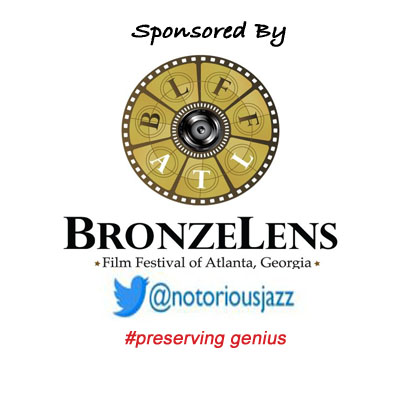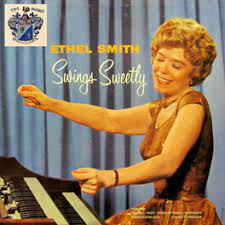
Daily Dose Of Jazz…
Ethel Smith was born Ethel Goldsmith on November 22, 1902 in Pittsburgh, Pennsylvania and began performing from a fairly young age. Traveling widely, after studying both music and several languages at Carnegie Institute of Technology, she became proficient in Latin music while staying in South America.
Smith performed in several Hollywood films such as George White’s Scandals and Melody Time. Her appearance in these films brought notoriety to her colorful, elaborate costumes, especially her hats.
Her rendition of Tico Tico became her best-known hit. She performed it in the MGM film Bathing Beauty in 1944, after which her recording reached the U.S. pop charts that November, peaking at #14 and selling nearly two million copies worldwide. Her other well known hits were Down Yonder and Monkey on a String.
Smith was a guitarist as well as an organist, and in her later years occasionally played the guitar live for audiences, but all her recordings were on the organ. She recorded dozens of albums, mostly for Decca Records.
Organist Ethel Smith, who became widely known as associated with Latin music, transitioned on May 10, 1996, at age 93 in Palm Beach, Florida.
More Posts: bandleader,history,instrumental,jazz,music,organ
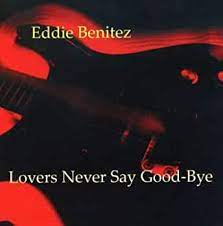
Daily Dose Of Jazz…
Eddie Benitez was born on November 12, 1956 in San Juan, Puerto Rico and his family moved to Europe soon after his birth for his father’s work. Raised in Italy and Spain, the family returned to the U.S. when he was nine and settled in Brooklyn, New York. He formed his first band at age twelve and began competing and winning local battles of the bands in Brooklyn. It was at one such battle of the bands where he was discovered by an AR person from Fania Records. Soon after the teenage guitarist was signed to the label.
Playing his first concert at Marcala la paz Honduras in front of 20,000 fans soon after joining the label in 1976, his performance with his band Nebula and the Fania All Stars marked the beginning of his early rise to fame as a guitarist. His debut release Nightlife was followed six months later with Essence of Life. He would later perform with such stars as Tito Puente and Mongo Santamaría.
His musical style began with Latin jazz as part of the Fania family, and would later incorporate smooth jazz and world music styles. His performing career came to a sudden halt at the age of 23 when he was diagnosed with Hodgkin’s Lymphoma, changing his life forever. Surviving cancer he took time off to reflect on life and spirituality and throughout his life Benitez has claimed to have had many spiritual visions, including those that occurred while overcoming a heart attack and an unexplained three-day coma.
He returned to performing with a private concert in Phoenix, Arizona in 2003 and it was there that reports that some in attendance saw mysterious beings, some would claim they were angels, on the stage with Benitez when he performed. That event gave rise to the title of his book and his tour.
Guitarist Eddie Benitez transitioned on January 17, 2019 in Scottsdale, Arizona.
More Posts: bandleader,guitar,history,instrumental,jazz,music
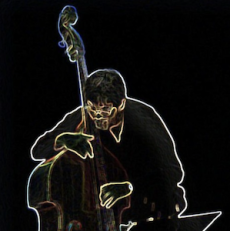
Daily Dose Of Jazz…
Manny Flores Jr. was born in El Paso, Texas on October 9, 1954. He spent his first eighteen years of life as an army brat, traveling and listening to music in a variety of different places. He began his playing career in the summer of 1971 at a gig at the Fort Huachuca NCO Club. At this time his inspiration for the bass was fellow left-handed bass player Paul McCartney. Graduating from Buena High School in Sierra Vista, Arizona in l972.
He also listened to jazz when he would buy Blue Note LPs at the bargain bin with Eric Dolphy and Charles Mingus among his favorites. He then graduated from Cochise College in Douglas, Arizona in 1974 with an Associates degree in Liberal Arts. By 1975 he was back in his hometown of El Paso and began playing in various groups including Top 40 and Country/Western groups in New Mexico, Wyoming and Arizona. Enrolling at the University of Texas at El Paso, he received his Bachelor of Music Education degree in 1982.
In 1983 he auditioned for and began playing with the El Paso Symphony Orchestra under the direction of Maestro Abraham Chavez Jr. He also began teaching instrumental music in the Ysleta Independent School District. During the decade Manny met many musicans who inspired him to make music a way of life including Frank Zappa, Jaco Pastorius, Ray Brown and Julliard cello teacher Harvey Shapiro.
In 1985 he began the first of a four-year trek to Victoria, British Columbia, Canada to attend the prestigious Johannesen International School of the Arts. He attended six-week master classes, and spent a summer in New York City studying jazz and listening to live performances of Charlie Haden, Marc Johnson, Harvie Swartz, and Eddie Gomez.
Flores has played with several big bands in addition to Bobby Saunders, Frank Dove and the Sundowners, Mario Otero, Crossroads, El Paso Brass Quintet, Bobby Booth Dixieland Band, M.D. Quartet, U.T.E.P. Lab Band I with Gene Lewis, Mike Francis Quartet, Gerald Hunter and the Quintones, Art Lewis and the Earthmen, Orchestra Puerto Rico, Spice of Life, Bing Browning Trio, Cecile Larochelle, The Platters, The Four Lads, The Four Aces, Jimmy Dorsey Orchestra, Mel Carter, Roger Miller, Johnny Mathis, Guy Lombardo’s Royal Canadians, Charlie Rouse and Boyz II Men.
By 1998 he made his first trip to Rio de Janeiro, Brazil to fulfill a lifelong desire to experience Brasilian music firsthand and to meet one of his favorite musicans Hermeto Pascoal. He hung out with his friends Albert Suhett, Itibere Zwarg, Marcio Bahia, and Hermeto. Marcio Bahia introduced him to bassist Adriano Giffoni with whom he studied with each summer in Rio.
Bassist Manny Flores Jr. is involved in the Universal Music movement and continues to perform locally in Austin and El Paso.
More Posts: bass,history,instrumental,jazz,music
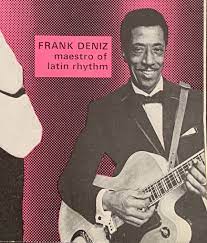
Daily Dose Of Jazz…
Frank Deniz was born Francisco Antonio Deniz on July 31, 1912 in Cardiff, Wales. His father, an African born in Cape Verde, was a seaman, and his mother was of English and African-American descent. They were amateur musicians, father playing violin and mother playing piano. From the age of 15 he joined his father on sea voyages. In 1931 his father was taken ill and the lad was forced to leave him in hospital in Odessa, Ukraine where he died. Between voyages he played music, inspired by jazz guitarists Teddy Bunn and Eddie Lang.
He married pianist Clara Wason in 1936 and they moved to London, England and found work as musicians in Soho. In 1937 they played for a time in the orchestra of Ken “Snakehips” Johnson. Deniz later played at Adelaide Hall’s Florida Club in Mayfair, where he played with pianist Fela Sowande.
Joining the Merchant Navy in 1940, he played music in between voyages with contemporaries Eric Winstone and Edmundo Ros, and formed his own band, the Spirits of Rhythm. In 1944 he was wounded when his ship was torpedoed on approaching Anzio.
Stanley Black, leader of the BBC Dance Orchestra employed him regularly and introduced him to others in the music business. Deniz joined Harry Parry’s Radio Rhythm Club Sextet, which had a regular radio series. In 1953 with his brothers, he formed the Hermanos Deniz Cuban Rhythm Band, which gave regular broadcasts in the 1950s regularly through to the 1970s.
Deniz composed music with his brother Laurence for the 1959 film Our Man in Havana. He accompanied Hoagy Carmichael on a tour of Britain. In his later years he played with the Hermanos Deniz band at the Talk of the Town. This continued for many years until his retirement in 1980, when they lived in Málaga Spain during the summer, until Clara contracted Parkinson’s disease in the 1990s. At this point Deniz became her caregiver until her death.
Guitarist Frank Deniz transitioned on July 17, 2005 at his home in Stanstead Abbotts, Hertfordshire, England.
More Posts: bandleader,guitar,history,instrumental,jazz,music
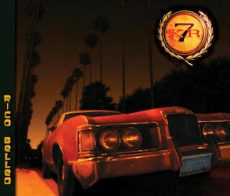
Daily Dose Of Jazz…
Rico Belled was born in the Netherlands on May 9, 1970 to Spanish/Swiss parents. Growing up in a multicultural environment, with a pianist father, he was exposed to many styles of music. He started playing piano at age 11, exploring everything from classical music to jazz. At 15 he started playing gigs with local bands doing pop and blues, while slowly getting interested in the bass, which he started practicing at age 17.
In 1989, while studying electrical engineering at the TU Delft, Rico met Roy Cruz in The Hague and joined his weekly Sunday night band at De Pater, exploring the world of Funk and Jazz playing Fender Rhodes. During these sessions they broke down all stylistic walls from playing Weather Report tunes to full on James Brown Funk, featuring as many as 10 people on the little stage. Here he got an education in the art of jamming.
Realizing music was his passion, in 1992 Belled gave up engineering and moved to Los Angeles, California and attended the Musicians Institute in Hollywood. Post graduation he was already playing with a few different groups in the Los Angeles area and in the following years made a name for himself as a bass and keyboard session musician. His breakthrough came when he joined Wrecking Crew pianist Don Randi and the house band at the Baked Potato in 1994. A two year residency offered the opportunity to lead his own group performing his original music at the club.
This led to him performing and recording with Marc Antoine, The Dan Band, Sound Assembly, Jeff Robinson, Leslie Paula’s Latin Soul Band, Liza Minelli, Chris Standring, Scott Grimes, Keiko Matsui and many others. He has co-written and published music with Mindi Abair and Jeff Robinson. All this led to him being asked to join the Rippingtons, starting with recording the album ‘Modern Art’, for which he received a Grammy Nomination in 2010. Still a member, bassist Rico Belled remains one of the top bassists in Los Angeles, known for his deep groove and versatility, staying busy live and in the studio.
More Posts: bandleader,bass,composer,history,instrumental,jazz,music



